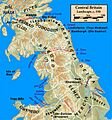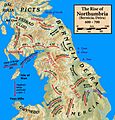Hen Ogledd facts for kids
Yr Hen Ogledd (Welsh pronunciation: [ər ˌheːn ˈɔɡlɛð]), which means the Old North in English, was a special historical area. It was home to the Brittonic people during the Early Middle Ages. This was after the Romans left Britain. Today, this area is Northern England and the southern parts of Scottish Lowlands.
The people living in the Old North spoke a language called Cumbric. This language was very similar to Old Welsh. The people of the Old North and the people of Wales saw themselves as one group. They called themselves Cymry, which means 'fellow-countrymen'. The Old North was different from areas where the Picts, Anglo-Saxons, and Scoti lived.
Some of the main kingdoms in the Old North were Elmet, Gododdin, Rheged, and the Kingdom of Strathclyde. There were also smaller kingdoms like Aeron and Calchfynydd. Areas like Eidyn (modern Edinburgh) and Manaw Gododdin were part of Gododdin. Over time, most of these kingdoms were taken over by the Anglo-Saxons and Picts by about 800 AD. Strathclyde lasted longer, joining the Kingdom of Scotland in the 11th century.
The memory of the Old North stayed strong in Wales. Welsh stories tell about the Gwŷr y Gogledd, or Men of the North. Many important Welsh families traced their roots back to them. Famous early Welsh writers like Taliesin and Aneirin are believed to have come from the North. Heroes like Urien and Owain mab Urien also appear in Welsh poems.
Contents
Life in the Old North
Not much is known for sure about Central Britain before 550 AD. The Romans never fully controlled the land north of the Tyne and Solway. Even south of that line, Roman control ended long before 407 AD, when the Roman military officially left Roman Britain. Writings from that time show that Roman control slowly faded from about 100 AD onwards. After 360 AD, there was a lot of disorder, and the Romans left many areas for good.
By 550 AD, Brittonic-speaking people controlled most of the region. The eastern coastal areas were held by the Anglian people of Bernicia and Deira. To the north were the Picts, who also spoke Brittonic languages before they started speaking Gaelic. Further northwest was the Gaelic kingdom of Dál Riata. All these groups played a part in the history of the Old North.
Conflicts and Alliances
Wars were common during this time. Britons fought against Britons, and they also fought against Angles, Picts, and Gaels. The Welsh stories about Britons fighting Anglians have matching stories from the Anglian side. The end of the Old North kingdoms led to the rise of the Kingdom of Northumbria. Northumbria grew from two coastal kingdoms to become a major power in Britain.
Kingdoms in this era didn't just care about their nearby areas. Alliances were not only made within the same ethnic groups. For example, Britons fought against other Britons at the Battle of Arfderydd. Áedán mac Gabráin from Dál Riata (a Gaelic kingdom) was listed in a Welsh family tree of the Men of the North. The Historia Brittonum says that Oswiu, a Northumbrian king, married a Briton who might have had some Pictish family. This shows how different groups mixed and formed alliances.
When one group conquered another, it didn't always mean one culture completely disappeared. The Brittonic area of northwestern England was taken over by Anglian Northumbria in the 7th century. But 300 years later, it reappeared as South Cumbria, joining with North Cumbria (Strathclyde) to form a single state.
Society and Law
The people of the Old North were organized into tribal groups. These groups were based on kinship (family ties). They were loyal to a main "royal" family, who offered them protection. This way of organizing society was common for Celtic people for hundreds of years. It can be seen in Irish, Welsh, and Scottish laws from that time. Anglo-Saxon law also had similar ideas, based on cultural traditions rather than Roman laws.
A king would have a main royal court (Welsh: llys), which was like a capital. But it wasn't a modern office building. The king would travel to many courts across his land. This allowed him to rule and help his people, for example, by making legal decisions. This old way of giving justice continued until Henry II changed the law system in England (1154–1189).
Language of the Old North
Modern experts call the Brittonic language spoken in the Old North "Cumbric". It was very similar to Old Welsh, with some small local differences. It was also related to Cornish, Breton, and an older form of Pictish. We don't have any full texts written in Cumbric. What we know comes from place names, names of people in old writings, and poems by early poets called cynfeirdd.
The cynfeirdd poems are our best source of information. Many believe parts of these poems were first written in the Old North. However, they only exist in later Welsh copies. We don't know how much they changed over time. Still, these texts show small differences that set Cumbric apart from Welsh. These differences are mostly old features that were once common in all Brittonic languages but later disappeared from Welsh. So, Cumbric and Old Welsh were very similar, with the main difference being where they were spoken.
Cumbric slowly faded away as the area was conquered by Anglo-Saxons, and later by Scots and Norse. It lasted longest in the Kingdom of Strathclyde, which was centered at Alt Clut (modern Dumbarton in Scotland). It's not known exactly when Cumbric died out. Some old counting systems in Northern England, recorded since the 1700s, were thought to be a sign of Cumbric survival. But most experts now think these systems were brought to England later.
Welsh Connections to the Old North
Many Welsh family histories say they came from the "Men of the North." For example, Cunedda, who started the royal family of the Kingdom of Gwynedd (a powerful Welsh kingdom), was said to be from the North. This shows a lasting link between Wales and the Old North. The Welsh and the Men of the North saw themselves as one people. The Welsh name for themselves, Cymry, comes from this old connection.
The word Cymry comes from the Brittonic word combrogi, meaning "fellow-countrymen." The Breton word kenvroiz still has this meaning today. People in the Old North started using Cymry for themselves in the early 7th century. It was used throughout the Middle Ages to describe the Kingdom of Strathclyde. Before this, and for some centuries after, the common term was Brythoniaid, which reminded people of a time when all Britons on the island were united. Cymry is still used today in the native name for Wales (Cymru), and in the English county name Cumbria. Both names mean "homeland."
Many old stories about the Old North come from Welsh traditions. Poets like Aneirin, who supposedly wrote Y Gododdin, are thought to have been court poets in the Old North.
Kingdoms of the Old North
Here are some of the main kingdoms and regions mentioned in old writings about the Old North:
Major Kingdoms
- Alt Clut or Ystrad Clud: This kingdom was centered at what is now Dumbarton in Scotland. It was later known as the Kingdom of Strathclyde. It was one of the best-known northern British kingdoms and the last to survive. It remained independent until the 11th century before joining the Kingdom of Scotland.
- Elmet: This kingdom was in western Yorkshire in northern England. It was south of the other northern British kingdoms. It managed to survive until the early 7th century.
- Gododdin: This kingdom was in what is now southeastern Scotland and northeastern England. It was the land of the Votadini tribe. The poem Y Gododdin tells about a terrible raid by an army from Gododdin against the Angles of Bernicia.
- Rheged: This was a major kingdom that included parts of modern Cumbria. Its full size is not known. It was strongly linked to its king Urien, whose name is found in places across northwestern Britain.
Smaller Regions
Several areas are mentioned in old writings. They were likely important regions within one of the kingdoms, or perhaps small kingdoms themselves:
- Aeron: A smaller kingdom mentioned in texts like Y Gododdin. Its exact location is unclear, but some experts think it was in the Ayrshire region of southwest Scotland. It was often linked to Urien Rheged and might have been part of his kingdom.
- Calchfynydd ("Chalkmountain"): Almost nothing is known about this area. It was likely in the Old North, as a ruler named Cadrawd Calchfynydd is listed in old family trees.
- Eidyn: This was the area around the modern city of Edinburgh, then called Din Eidyn (Fort of Eidyn). It was closely connected to the Gododdin kingdom. The name might still be seen in names like Edinburgh and Dunedin. Din Eidyn was attacked by the Angles in 638 AD and was under their control for about 300 years.
- Manaw Gododdin: This was the coastal area south of the Firth of Forth. It was part of the Gododdin territory. The name lives on in places like Slamannan Moor in Stirlingshire.
- Novant: A kingdom mentioned in Y Gododdin, probably linked to the ancient Novantae tribe of southwestern Scotland.
- Regio Dunutinga: A small kingdom or region in North Yorkshire. It was named after a ruler called Dunaut. Its name might survive in the modern town of Dent, Cumbria.
Other kingdoms that were important to the history of the Old North, even if they weren't Brittonic, include:
- Dál Riata: A Gaelic kingdom.
- Northumbria and its earlier states, Bernicia and Deira.
- Pictish kingdom.
Possible Kingdoms
Some names appear in old writings, but we don't know for sure if they were British kingdoms in the Old North:
- Bryneich: This was the British name for the Anglo-Saxon kingdom of Bernicia. There might have been a British kingdom here before the Anglian one, but it's not certain.
- Deifr or Dewr: This was the British name for Anglo-Saxon Deira, an area between the River Tees and the Humber. The name is British, but like Bryneich, we don't know if it was an earlier British kingdom.
Images for kids
See also




